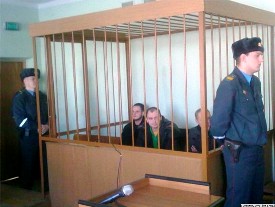Analysis of the criminal trial of Aliaksandr Atroshchankau, Aliaksandr Malchanau and Dzmitry Novik
Aliaksandr Atroshchankau, Aliaksandr Malchanau and Dzmitry Novikau were
charged with committing a crime under Part 2 of Art. 293 of the Criminal Code (rioting).
Malchanau was also charged under Art. 370 of the Criminal Code (outrage of state
symbols).
All the defendants were in custody in the KGB jail since
their arrest: A. Atroshchankau – since 20 December 2010, A. Malchanau – since
6 January 2011 and Dz. Novik – since 23 December 2010.
The criminal case was considered by the Judge of the Frunzenski District Court of Minsk Cherkas Tatsiana
Stanislavauna, the public prosecution was represented by prosecutor Tatsiana
Maladtsova. The trial lasted two days 1 and 2 March 2011.
Dzmitry Lepesh, representative of the civil plaintiff (the Main Economic
Council of the Presidential Administration), didn’t attend the trial and
submitted to the court a refusal from the lawsuit due to the compensation of
the material damage.
According to the verdict,
all defendants were found guilty of the alleged crimes. A. Atroshchankau was
sentenced to 4 years of imprisonment, A. Malchanau – to 3 years, and Dz. Novik
– to 3.5 years.
Access to justice:
the hearing of the held was held in open court proceedings. However, the access of media correspondents, human
rights defenders and citizens to the court hall was limited due to its size. Moreover,
on the second day of the trial some 15-20 students were brought to the court
hall in advance, by means of which the access of the interested sides
(including representatives of foreign media, human rights defenders and
citizens) was further limited, though representatives of the state media and
neighbors were the let in the court hall.
Defense: All
the defendants were represented by lawyers who carried out their protection
during the preliminary investigation.
The essence
of the charges:
Aliaksandr Malchanau was charged with having torn down two state flags from the
KGB building in Nezalezhnastsi Street, 17, Minsk, being in inebriated state,
thus violating Article 370 of the Criminal Code (‘outrage of the state
symbols’), and also with having knocked out the entrance doors of the House of
the Government by previous concert with Novik, Atroshchankau and some
unidentified persons (they hit the doors at least two times with his fists and
at least two times with his feet and took other active actions to penetrate the
building), which falls under provisions of Article 293, part 2 of the CC, ‘mass
riot’ – direct participation in the mass riot, which was accompanied with
violent actions and disobedience.
Dzmitry Novik was charged with having taken part in the mass riot on 19 and 20
December 2010 in
Minsk by
previous concert with Atroshchankau, Malchanau and unidentified persons. In
particular, he damaged the entrance doors of the House of the Government (he
delivered at least 21 blows with his fists and feet and took other active
actions to penetrate the building), which falls under provisions of Article
293, part 2 of the CC.
According to the accusation, Aliaksandr Atroshchankau, together with a
disorderly crowed, by concert with Novikau, Malchanau and other unidentified
persons, took part in mass riot accompanied with armed resistance. In
particular, he delivered at least one blow and took other active actions
falling under provisions of Article 293, part 2 of the CC.
Aliaksandr Malchanau completely confessed his guilt, Dzmitry Novik confessed
the guilt partially and Aliaksandr Atroshchankau pleaded innocent.
In general, the trial correspondent to requirements of the Criminal Process
Code.
The accused were questioned at the trial and evidence in the case was examined:
video materials were demonstrated and written materials were studied.
As a result, the court
concluded that the guilt of the accused was fully proven and their actions were
properly qualified. The court handed down a guilty verdict.
Having analyzed evidence in the case and
monitored the trial the Human
Rights Center
Viasna reached the
following conclusions:
The court provided no
evidence that the events of 19 December of 2010 in the Nezalezhanstsi Square
were a riot and that, accordingly, the defendants took an active part in it.
Mass riot – is actions by a crowd, which acts
without organization, and shows unrestrained and furious aggression.
The mass riot in the sense of Art. 293 of the Criminal
Code must necessarily be accompanied with personal violence, pogroms, arsons,
property destruction and armed resistance to the authorities. Other members of
the crowd, which disturbed the public order, ensue the administrative
responsibility, while a rough nature of these violations may be an offense
under Art. 339 (disorderly conduct), or 342 of
the Criminal Code (group actions grossly violating public order) of the Republic of Belarus.
Participation in mass riot must manifest directly
in acts of personal violence, pogroms, arson, property destruction, armed
resistance to the authorities.
Pogrom is any action accompanied with violence, destruction or theft of property.
Violence during mass riot - is causing bodily harm,
beating or deprivation of liberty.
Arson – is a means of destruction of property, usually in socially
dangerous way.
Armed resistance to the
authorities – mental or physical abuse with the use or the use of various
weapons in order to obstruct the legitimate activities of public officers. Arms
here mean any kind of weapons considered as such by the Law of the Republic of Belarus On Weapons of 13 November 2001.
As it follows from
testimonies of the questioned witnesses and viewed videotapes, actions of A.
Atroshchankau, A. Malchanau and Dz. Novik weren’t accompanied with armed
resistance to the authorities, personal violence, arson, smashing up. It hasn’t
been proved that any property was destroyed by their actions. The previous
concert between the accused and other persons wasn’t proved either.
In particular, witness Dzianis
Valeryievich Antonau, officer of the Main Police Bureau of the Minsk City
Executive Committee, shot the action on video on 19 December. He stated that
there was no particular aggression in the crowd. It was a usual demonstration.
The traffic didn’t move because of the pedestrians. The road police asked them to
free the carriage way, but the demonstrators didn’t pay attention to it. He
explained that he had seen Atroshchankau. The latter wasn’t in the first row on
the stairs of the House of the Government. He didn’t touch the barriers. He
swung together with the crowd. The people pushed the doors. He saw Novik, who
tried to burst into the House of the Government. He watched Novik and Atroshchankau
simultaneously, but there was coordination between them, they didn’t speak to
each other. He didn’t see that something was damaged by actions of Novik and
Atroshchankau or somebody was injured by them. Later the police pushed the
people away from the House of the Government, lined up in front of it and then
went away, as they were given such an order.
Witness Mikalai Aliaksandravich Shalko,
a senior expert of the Main Police Bureau of the Minsk City Executive
Committee, shot the illegal actions on video. As said by him, there was no
traffic movement along Nezalezhanstsi
Avenue in the evening of the action, as the road was
cordoned by the road police. The witness explained that he had seen
Atroshchankau on the stairs of the House of the Government. Atroshchankau was
distinguished by his stature and cap. He didn’t stand in the first rows. The
people were making something like a human battering-ram. All in all, there were
some 1-2 hits of this ram. The witness didn’t see Atroshchankau deliver blows.
Novik, as it seems to him, had a photo camera and tried to make photos. In
general, there were some 7-10 people who were most active. The situation wasn’t
coordinated, everything happened spontaneously. As a result, the doors were
broken and the windows were smashed. The witness didn’t see who did it. There
were no arsons and armed resistance on 19 December. The witness only saw how
demonstrators fobbed off the police with fishing rods.
The video materials studied as evidence witness neither
the use of weapons by participants of the demonstration, nor arsons or armed
resistance on their part. Moreover, the results of the expert examination which
were voiced at other trials concerning the events of 19 December (the trials of
(Parfiankou, Gaponov and Breus) didn’t classify the items found on the Nezalezhnastsi Square
(ice axes, an axes, etc.) as cold weapons.
In general, the number of
the people who took part in the breaking of glass in the House of the
Government is quite small compared to the number of other participants of the
demonstration. The overwhelming majority of participants of the demonstration
in the Nezalezhnastsi Square
didn’t commit violations of the public order or violent actions against police.
Some property owned by the Main Economic Council of the Presidential
Administration was damaged, but not destroyed as a result
of actions of a small number of people, namely: one rainwater pipe, the glass
in several windows of the building and five juniper bushes. This property was
partially restored the following day. The material damage, inflicted to the property
Main Economic Council of the Presidential Administration, worth 14 million rubles was fully repaid at the beginning of
the court sitting. It must be also noted, that the property wasn’t damaged by arson
or in any other socially dangerous way.
The court didn’t provide evidence that any property was
damaged by actions of A. Atroshchankau and Dz. Novik.
The confession of guilt by Malchanau shows that
his actions could be qualified as an offense (defilement of property), but
doesn’t prove his involvement in a mass riot. We believe that in the course of
the trial there wasn’t found any evidence of outrage of the state symbols
because the two state flags removed by Malchanau from the KGB building weren’t
damaged were returned to the previous
position after 20 minutes. The court also didn’t present evidence that by his
actions Malchanau offended the state symbols (publicly tore them up or
trampled).
In this regard, the Human Rights Center Viasna believes that the court's
conclusions that were stated in the verdict, don’t correspond to facts of the
case and are not supported by evidence.
The Human Rights Center Viasna considers that no evidence of his guilt in committing a crime
under Part 2 of Article 293 of the Criminal Code was presented at court.
The Human Rights Centre Viasna states the sentence of the Frunzenski District Court of Minsk is
politically motivated and unlawful, and insists on its abolition and the urgent
release of convicts A. Atroshchankau, A. Molchanau and Dz. Novik.


















